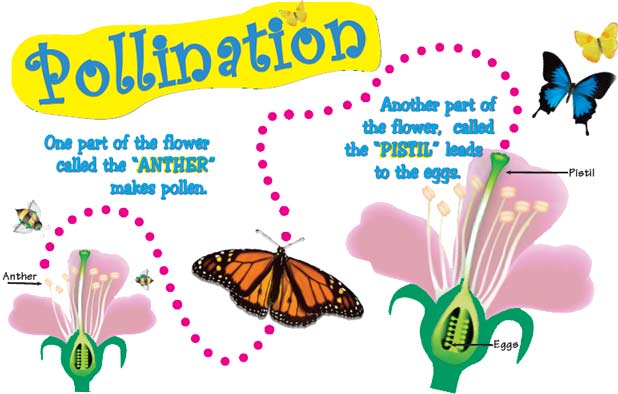Pollination
The
process of transfer of pollen grains from anther to stigma is known as pollination. The pollination may be:
Ø
Direct
pollination
In gymnosperms,
ovules are present outside the ovary hence pollen grains falls directly on the
ovules.
Ø
Indirect
pollination
In angiosperms,
ovules are enclosed inside the ovary hence the pollen grains falls on the on
the stigma but not on the ovules. These are again classified into 2 types.
o
Cleistogamy
The pollination which occurs in unopened
flowers
Examples: Commenlina bengalensis, Oxalis
acetosella, Viola odorata
o
Chasmogamy
The pollination
which occurs in opened flowers. It is the most common pollination in all type
of flowers. It is sub divided into:
·
Self pollination/Autogamy:
The transfer of pollen grains from
anther to stigma in the same flower.
Examples: Lily, Rose
·
Cross
pollination/Allogamy:
The transfer of
pollen grains from anther to stigma of another flower but same species. It
occurs in 2 types
§
Geitonogamy
The pollination between two flowers present on the same
plant and the pollen grains of one flower falls on the stigma of other flower.
Example:
Cucurbita.
§
Xenogamy
The pollination occurs between two flowers present on
different plants and the pollen grains of one flower of same type present on
another plant.
Example: Pyrus
malus

Ø
Advantages
of Cross pollination
·
Productivity of seed is more through cross
pollination.
·
Seeds are large, healthy, germinate quickly and
the yield is more.
·
Plants occupy very less space and the production
of flowers is more.
·
Plants show genetic variation.
·
Plants have resistance for disease.
Ø
Contrivances
for Cross pollination
·
The flower of same plants shows different
modifications by which self pollination is prevented and cross pollination is
carried out.
·
If flowers are bisexual self pollination occurs
and unisexual cross pollination takes place (flowers may be staminate/Pistillate)
Examples:
Vallisneria, Papaya
·
In some flowers, androecium and gynoecium mature at different times hence cross
pollination takes place.
·
In some bisexual flowers, androecium and gynoecium mature at same time but self pollination
is prevented by the arrangement of stigma and stamens at different lengths
which promotes cross pollination.
Ø
Agents for
cross pollination
The pollen grains
are not capable of reaching stigmas spontaneously hence they take the help of
external agents like air, water and
birds/animals. Based on these agents, they are of 3 types:
This pollination which occurs through the wind. The plants in this may be short (Oryza) or big and long (Borassus).
These flowers exhibit some special features like:
·
Plants grow in places where the velocity of wind is more.
·
Flowers are not showy and produce more amount of
pollen (dry and light in weight.)
·
Flowers are
bisexual and protandrous.
·
Perianth lobes may be reduced/absent where as essential organs elaborates.
·
Stamens show versatile fixation(drooping filaments).
·
Inflorescence is normally spike, catkin/spadix.
·
Some flowers with winged pollen grains (Pinus).
·
Stigmas may be sticky which helps in catching pollen.
·
Flowers do not produce scent/nectar.
This pollination occurs
through the water majorly in hydrophytes.
The plants in this produce long, needle like pollen grains. These are of 2 types:
·
Epihydrogamy
The pollination which occurs on the surface of water.
Example:
Vallisneria
§
Pollination
in Vallisneria
Male flowers are
detached from the male plant and float on the surface of water. At the same
time, female flowers come on to the surface of water by a long pedicel hence,
the pollen touches the stigmas and cross
pollination occurs.
After pollination,
the pedicels of female flower coils like a spring a pull the flowers
to the bottom and thus fertilization takes place under the water.
·
Hypohydrophily
The pollination which occurs below the surface of water.
Example:
Zostera
§ Pollination
in Zostera
At maturity,
anthers produce needle like pollen grains. These will remain suspended in
water. The styles are long with sticky stigmas to hold the pollen grains. Hence
the pollination occurs below the water.
This pollination occurs by the animals. Based on
the type of animals they are 5
types:
·
Ornithophily:Pollination
by birds
Examples: Delonix - Humming
birds,Bigonia –crows and mynas.
·
Cheiropteriphily:
Pollination by bats. Examples:Oroxylum,Musa
·
Malocophily:
Pollination by slugs and snails.
Example: Lemna sulami
·
Ophiophily:
Pollination by snakes
Example:Arisaema
·
Cantharophily:
Pollination by beetles. Example:Cycas.
·
Entomophily:
Pollination by insects.
Example: Bees.
Ø
Characters
of Entomophilous flowers
·
Size:
Large and showy to attract the insects. If the flowers are inconspicuous and attract the insects.
Head
inflorescence: Sun flower
·
Colour:
Flowers become showy with coloured petals and perianth lobes. Insects are attracted by these colors.
Examples: Bouganvillea ,Passiflora
·
Scent:
The olfactory sense is more in insects than in human beings. Generally
nocturnal flowers are not showy but produce scent to attract insects. Examples: Nyctanthus – Night Jasmine
Jasminum officinale – Jasmine
Some flowers emit
smell of rotten meat which attracts the flies
Example: Rafflesia arnoldi
Sometimes scented
leaves attracts the insects
Example: Coriandrum Some flowers
attracts insects by both (colour, scent)
Example: Rose.
·
Pollen:
Flowers produce more amount of pollen to attract insects (sterile and
proteinaceous)
Examples:
Argemone ,Calotropis
·
Nectar:
Flowers produce honey to attract insects.
Example: Ixora
Generally,
nectaries are present at the base of the ovary. In some flowers they are
present in different parts of the plant other than flowers (extra-floral
nectaries).
Examples:
Pass flora – Petioles, Euphorbia – Involucre
...................................THE END....................................
| 




